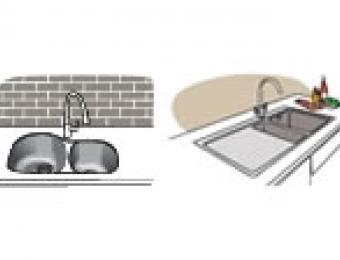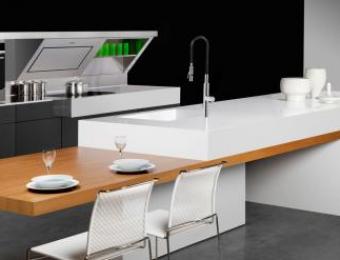
Kitchen design and style play a big role in deciding what sink will best fit your requirements. In addition to choosing a sink material that matches the overall 'feel' of your kitchen, you'll need to take into account how much space you have, where it is in relation to everything else in the kitchen, how much entertaining you'll do, how big your family is and how serious you are about cooking.
These considerations, in turn, will naturally lead you to conclusions about the size, number and depth of the basins, and how your sink and drainboards will need to be arranged on your benchtop.
Consider the space around the sink - how much counter space do you require for appliances, or stacking pots and pans when you're washing up?
Do you desperately need extra cupboard space underneath the sink? An undermount sink will take away some of the cupboard space under the sink - as will a drain pipe that leads out from the centre of the basin. For extra cupboard space, consider a sink with wastes positioned right in the back corners of the bowls so that the plumbing's nicely tucked away.
It's well worth giving plenty of thought to what you need from your kitchen sink (particularly in terms of how it'll be laid out) because it's likely to be a decision you'll only make once - and poor placement will cause you a lifetime of irritation. As a general rule you'll never be left wanting with more sink space or larger bowls, but if you have any doubt, talk to a kitchen designer.
Choosing bowl sizes
The sink formation you choose (e.g. 2 bowls, draining board on the right) must fit with your kitchen design requirements. There's no one-size-fits-all sink configuration, however there are a few things to keep in mind beyond the obvious when you're choosing.
Basin lengths typically range from 56cm in length to 120cm in length. Basins with deep bowls are essential if you frequently use large pots, however shallower basins can make a huge difference if you're a bit vertically challenged. High-set smaller sized bowls (either standalone, separate from your main sink or as a second bowl) are great for peeling and washing vegetables.
Things to consider when measuring for your sink
Sink measurements are important - and while the builder will normally know what's required, there are a few things you might like to keep in mind when choosing:
- Depth is the distance that covers the top of the sink's rim to the bottom of the drain (i.e. not the top surface of the bench)
- 'Bowl taper' refers to the sink’s inward slope on both sides from top to bottom.
- Radius measures where the sides and bottom meet.
- How straight the slope is depends on how deep the bowl is. The sink is better with a smaller radius.
Bowl configuration
The configuration of the bowls in your sink is important if bench space is limited, or even if you have more counter space than you know what to do with. The most functional sinks have a side-by-side configuration - but before you decide which configuration is right, you'll first need to determine whether you need/want a single bowl, double bowl, and equal or unequal sized bowls and drainboard(s).
When you're sure you know how many bowls and drainboards you need, work out how this configuration will fit into the kitchen. For most people, having the drainboard on the right will be natural, although a small minority of people prefer to wash from right to left.
For plumbing purposes, you'll also need to ensure there's enough space under the sink so that the correct piping and plumbing can be installed. You also need to take into account whether you require a waste disposal unit, and how your dishwasher will connect to your drains.




